Mikan and Soy Sauce
From Hoshiya to Yuasa along the Kii-ji route of the Kumano Kodo
Hoshiya to Kainan City
I got lost immediately. I followed the signs to the wrong oji shrine, the next one after the one I was aiming for. While I was trying to find the correct oji shrine, a man working in his garden told me about the nearby oji and where the missing oji was located. He told me he had walked the Kumano Kodo from Kyoto the previous year. Then he ran off and returned with a paper bag of grapes.
I couldn’t find the missing oji, no matter how hard I tried, so I wrote it off as a lost cause and hoped the grape giver wouldn’t be around on the way back to ask about the oji. After he had spent so long giving me directions and telling me information about the oji I didn’t have the heart to tell him I hadn’t visited it. I did see the grape giver, but he didn’t ask about the oji, just offered to accompany me to the next oji and beyond so I wouldn’t get lost.
I wound through lanes, under ripe persimmons hanging from boughs over grey walls. Green Satsuma oranges dangled like seasick baubles in small orchards. I passed over a crystal clear river filled with huge dark grey carp; one turned and flashed a pale side. As I walked alongside the river smaller fish pulsed downstream with each step I took above.
I reached the edge of the Kinokawa plain and began to climb up through a village. A white van trundled behind me, obviously frustrated by my slow progress. But the walled lane offered no refuge that would allow the van to pass me. These small white open-backed utility vans are incredibly common in Japan. Small tradesmen and workmen use them, as do farmers, so they are the Ford Transit and Land Rover of England rolled into one.
Mr. Yamamoto was the best dressed walker I have ever seen. He looked like he had set out to watch a game of cricket on a village green in England. He wore a spotless cream trilby with matching jacket and trousers. We sat at a picnic table thoughtfully provided near one of the oji remains. I gave him some of my grapes and he gave me one of his onigiri rice balls. He had come from Osaka to walk this section of the Kumano Kodo.
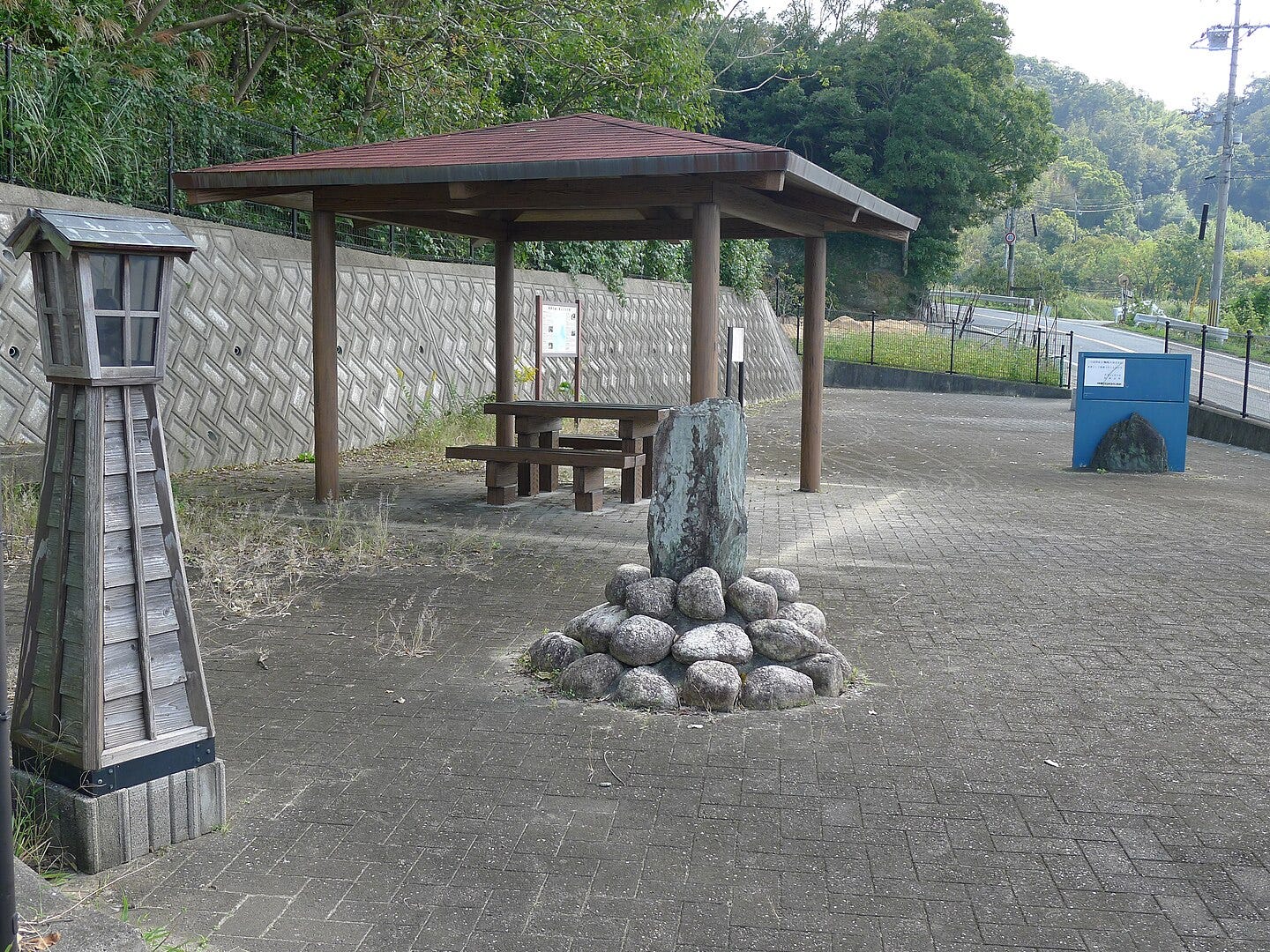
I was elated to discover the first proper section of path on the Kumano Kodo. It ran over a ridge while the main road passed beneath through a tunnel. I passed through my first bamboo forest, although half the bamboo seemed to be falling over and squeaked alarmingly against the remaining standing bamboo.
I moved on through a landscape of low bamboo-covered hillocks. The bamboo came in varying shades from a bright green fringed with brown to a much darker green. In the next village the retaining walls around the houses were built with a blue-grey-green rock rather than the usual dull grey concrete.
I passed through a valley neatly bisected by a railway line. Weeds grew between the tracks but the rails were smooth and shiny and continued across a low ridge into yet another valley. On a concrete ramp that dropped into a paddy field I sat, ate some grapes and pondered the route.
I went under an expressway and met a series of lakes with herons poised staring into the murky water. Beyond that the road ran into a construction site. A broad strip of bamboo across the far hill had been cut down, leaving cropped stubble like a newly-shaved prisoner’s head. The strip cut through the end of the hill, leaving a small isolated section to one side like the crusty end piece of garlic bread that nobody wants. I thought at first, they were making a new road, an example of the “roads to nowhere” famed for increasing Japan’s debt. But when I passed it a few weeks later, I realised they were merely burying a pipeline. The bamboo would be back.
In a field I saw a young woman helping to harvest the rice. Before this I had only ever seen older people (both men and women) working in the fields. The average age of a Japanese farmer is 68.7 years according to Statista.com.
After passing through another village I spotted a gaunt man with a rucksack (a description I later realised could equally well apply to me) across the rice fields walking on a path parallel to mine. I guessed he too was walking the Kumano Kodo. Later, while walking along a main road I started a Formula One race with him. Our pace was similar, so periodically I would catch up with him and want to overtake him. This was awkward on the narrow verge so I crossed the road and selected the inside of the bend to overtake him. But then I was on the outside of the next bend and he overtook me. This race continued for some time until I finally let him speed off into the distance as I yet again pondered my position on the map.

When I entered the outskirts of Kainan City, I made a detour to see a shrine that was marked on my map. It was disappointing — just a shrine on a hill, I’m not sure what I expected. All I had to show for my trouble was even more knackered feet and a series of insect bites on my arm. The next oji up an overgrown path proved little more interesting. As the tallest person to have walked this way in a while I kept crashing into spiders webs, sending the wasp-marked spiders into a distressed state as they watched days of careful web construction destroyed in seconds by an oafish creature with a huge hairy head.
In a riverbed below the oji I could see some of the blue-grey rocks I had seen in the villages earlier. A huge dark grey carp cruised like a submarine among them.
When I reached the railway station, I realised that the paper bag containing my grapes had split. This would have been no great problem except for the fact that I had been meticulously putting my spat out grape pips back in the same bag. They were now scattered all over the contents of the rucksack, sticking to everything. Months later I would still find grape pips stuck to the bottom of socks or lying on my living room floor even though I washed the bag out as soon as I returned.
Kainan City to Yuasa
The hillsides were steaming from overnight rain when I left Kainan City station. On the damp pavement lay the first yellow curls of fallen leaves, and for the first time since Osaka I had to wear a sweater.
My first target was Haraedo Oji, approached up a slippery woodland path littered with squishy chestnut wrappings. There was little to see at the site of the oji except a stone marker and a graveyard.
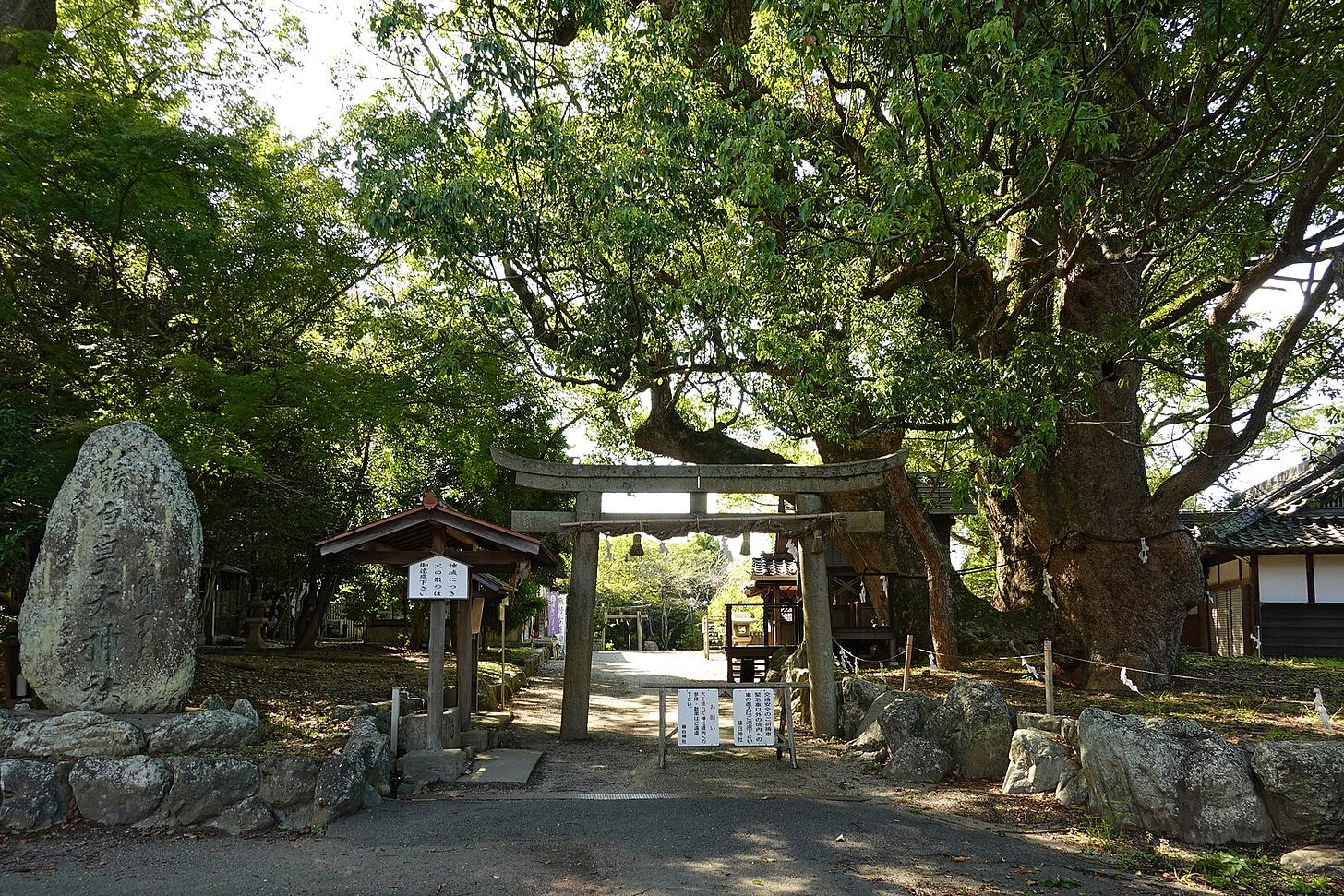
It was festival season in Japan, and at the shrine grounds I passed through, a stage had been set up and women were busy sweeping the ground with brooms clearing every last leaf. The festival season generally coincides with the harvest. After a long ascent I had some good views back across Kainan City. I was climbing up through orchards filled with the dimmed lanterns of kiwi fruit when I encountered my first serious path section of the Kumano Kodo. At first I couldn’t believe that I was supposed to go up the path, it looked too small and steep, so I followed a section that looked larger and better-used. This returned me to the farm road I had been on. A farmer drove up behind me in his white van and asked where I was going. When I replied that I was following the Kumano Kodo he told me I had gone past the turn off at a corner. He then led the way in his van and gesticulated up the path I had turned down before. I still couldn’t quite believe that this was the correct path, and double-checked the map again. Eventually, I allowed myself to be convinced this was the right way.
The steep path was marked with numbered markers. Cobwebs and spiders dangled from the encroaching overhead branches as I entered a forest. A section of bamboo forest gave me a break from the cobwebs – they were too tall and straight for the spiders to weave their webs a cross the pathway. I broke out of the bamboo forest into a misty clearing. A stone trough lay filled with fresh rainwater and dully gleaming coins. After passing over the ridge I dropped down to a small temple which was the next oji. A huge fishpond covered with netting to keep off the herons lay in the dip with the temple.
I began to descend from the heights down an extremely steep path. At one point something heavy like a large stone dropped onto the path ahead of me. I froze, wanting to see a monkey or some other large animal I had not yet spotted in Japan — I couldn’t see anything. The path was littered with ancient mikan oranges and the air was filled with the sour smell of rotting mikan.
A pretty village nestled in the valley at the bottom of the slope. An attractive wooden bridge crossed the small river in the centre of the village. From here according to the sign by the bridge, pilgrims could hire palanquins to transport them along the next uphill section.
I passed through another village, strung out along a river; it reminded me of a Tyrolean village with its profusion of flower baskets and wooden buildings. At a shrine beyond the village some men appeared to be putting up a decorative sign for a festival. Upon reading the blue oji sign at the shrine I realised I had just missed a sumo festival at the shrine. It was the first shrine I had seen in Japan with a miniature sumo wrestling ring. I asked the men when the sumo festival was, as they appeared to be setting up for a festival, not clearing up. They told me the festival would be tomorrow.
As I left the village, a woman with a small boy spotted the approaching foreigner. I said konnichiwa and he replied in kind, but then his mother encouraged him to say hello in English. This is one of the problems of the English teaching system in Japan. A wave of Assistant Language Teachers (like myself) teaching English in high schools, eikaiwa English conversation schools and foreign movies that are mainly English language in origin has led to a stereotype that all white people speak English. Sometimes, I am tempted in this kind of situation to say that I don’t speak English at all, but another language, and see how they react.
After the village the Kumano Kodo path was marked by scarlet ribbons tied to trees and posts. There was no danger of losing my way as I approached yet another crest of a ridge. A light rain began to fall as I cleared the crest. Far below, in roof-tile grey seas, a fishing boat churned a dirty white V which gradually curved away into the murk. A scarlet ribbon had fallen from a tree onto the damp, twig littered ground. I picked it up and attempted to re-tie it, but the branch was too soft and broke off in my begrimed fingers. It seemed wrong to leave it on the ground. I dangled it over another branch and hoped it would stay there.
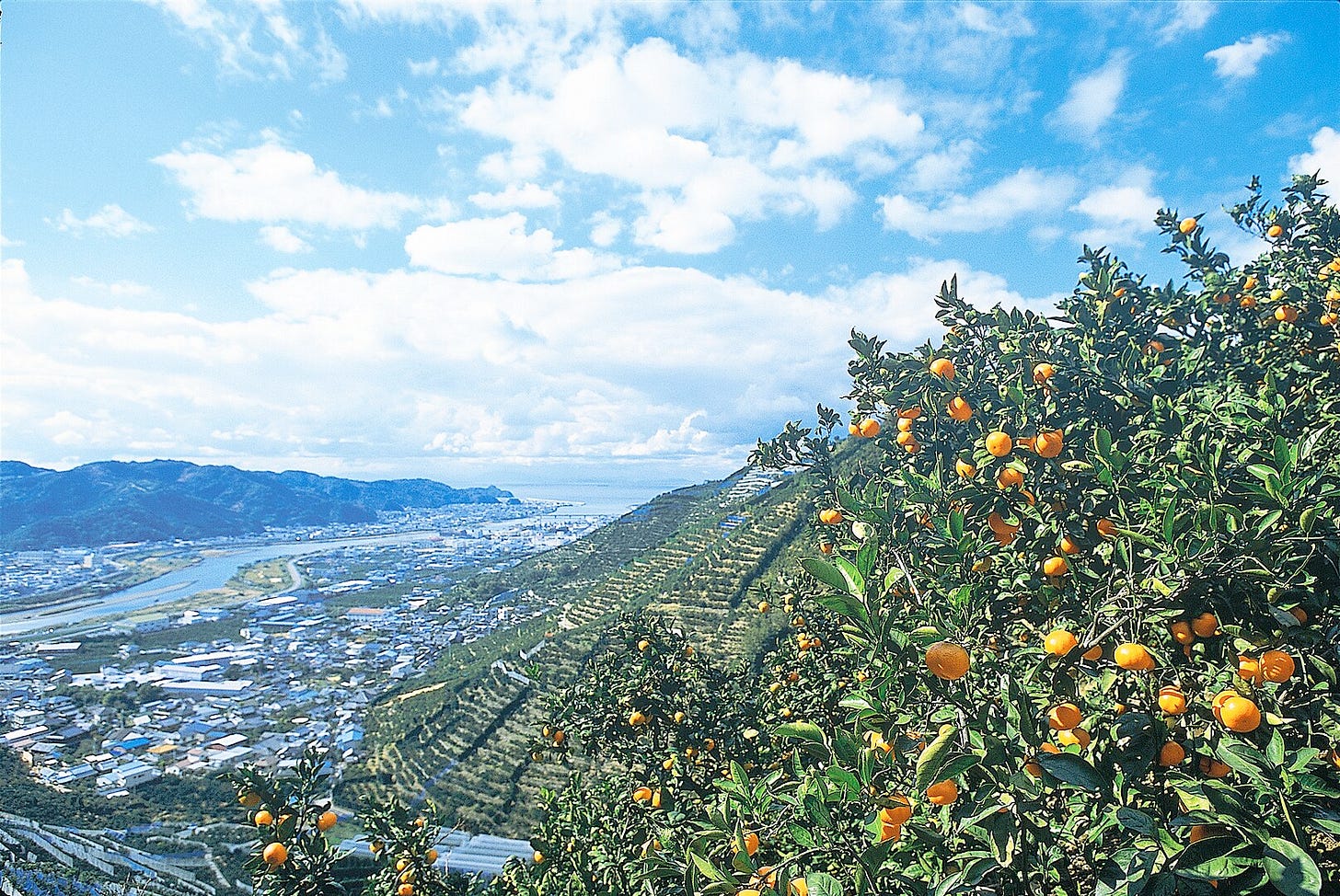
I descended into the mikan-growing area of the Arida valley as the sun came out. A row of wind turbines stood on the ridge opposite. Some were complete, but motionless, others just stumps awaiting their blades. I passed through Arida City but found no restaurants, so I had to reassure my growling stomach until I crossed over the Arita River and found a restaurant next to a large shopping centre on the other side. I stretched out my aching legs and sipped the glass of iced-water that is unfailingly brought to you in Japanese restaurants while waiting for my donburi egg and rice bowl meal.
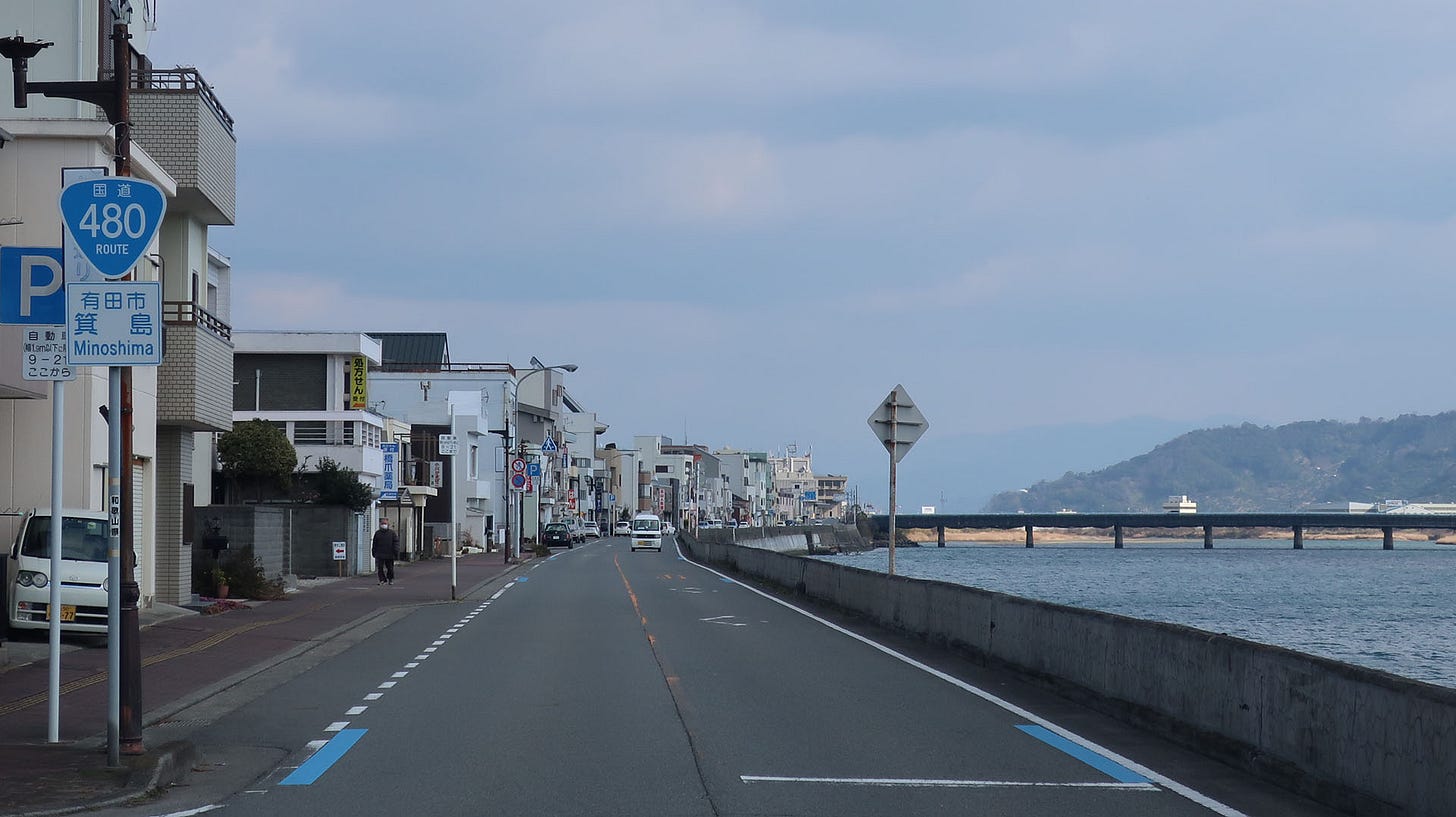
Before I resumed climbing to reach the soy-sauce manufacturing city of Yuasa I encountered a large temple filled with middle-aged mostly female hikers. I pushed on in order to escape such a large group of hikers. Winding my way up through the mikan orchards, I took a wrong turn on the confusing network of concrete pathways among the fruit trees. I could hear the hiking group noisily gabbling away below as I desperately tried to find my way back to the correct path. I burst out of the trees just in front of the startled hikers, waved, shouted “machigatta” — wrong, pointing down the path I had just come from and marched off up the correct path again.
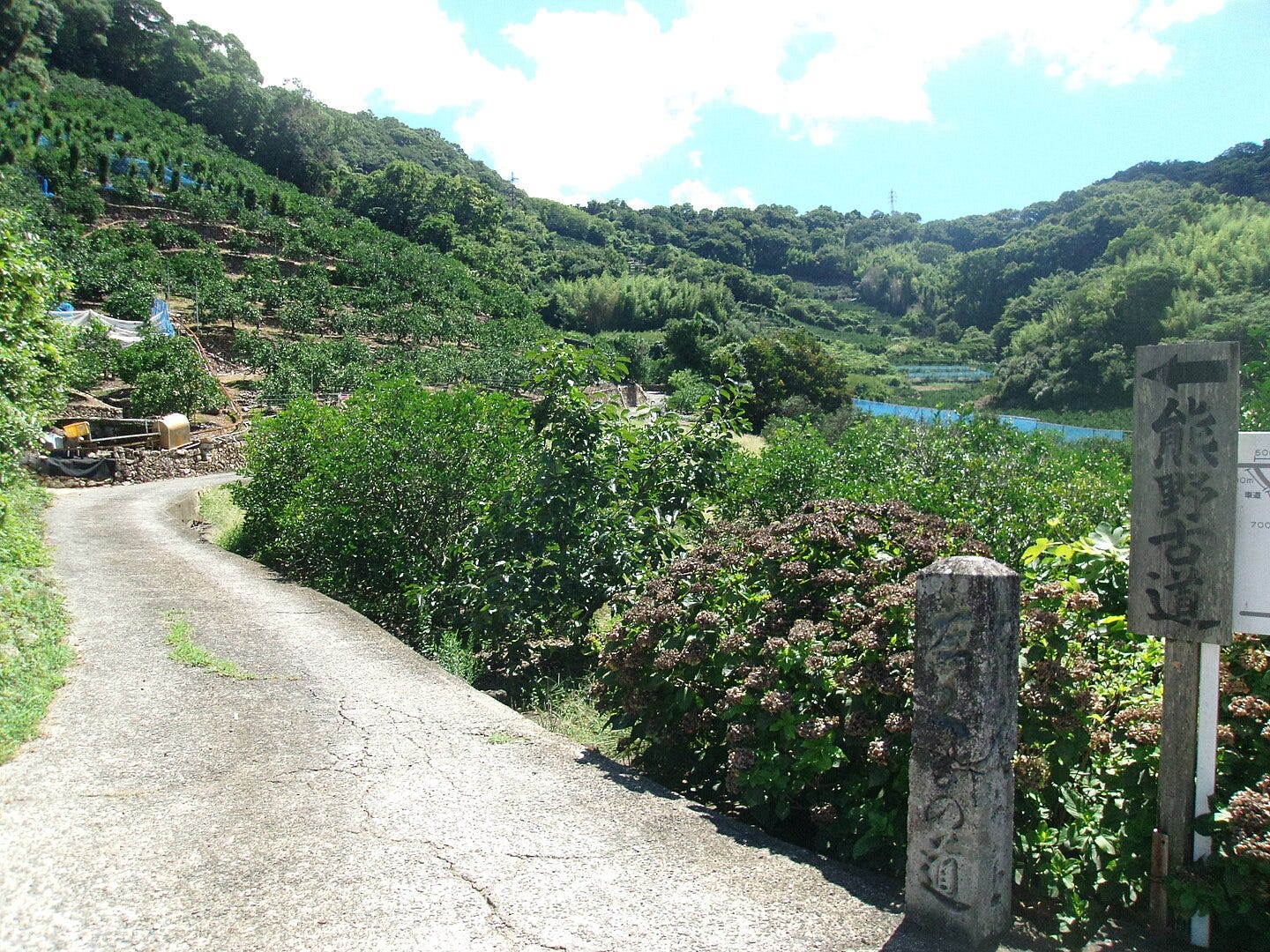
I just about managed to keep ahead of them across the pass to Yuasa, and as I dropped down past pools next to a deeply shaded path I left them behind for good. At the bottom of the pass lay the interestingly named “Reverse-flow shrine”. The reverse flow was a reference to the river which flowed from west to east rather than east to west into the Inland Sea as most rivers did in this area.
While attempting to find some soy sauce to buy as a souvenir in the centre of Yuasa, I came across a volunteer tourist centre. Some very kind ladies gave me green tea, sat me down, and asked me lots of questions about where I was from and what I was doing. Eventually, I took photos with a few of them. I was about to leave when a round, heavily-perspiring gentleman entered the centre. He sat down and proceeded to practice his English on me. I countered with terrible Japanese. His name was Naoya. He was a high school teacher from Izumi-Tottori, a town near Kansai airport I had passed through on an earlier section of the Kumano Kodo.
I was ready to leave Yuasa, all I needed was the soy sauce souvenir. The ladies showed me the way to the sauce breweries on the map. The teacher insisted on showing me the way. I felt ungrateful, but really I wanted to go there by myself. I had a feeling it was going to be hard to shake him loose. And so it proved to be.
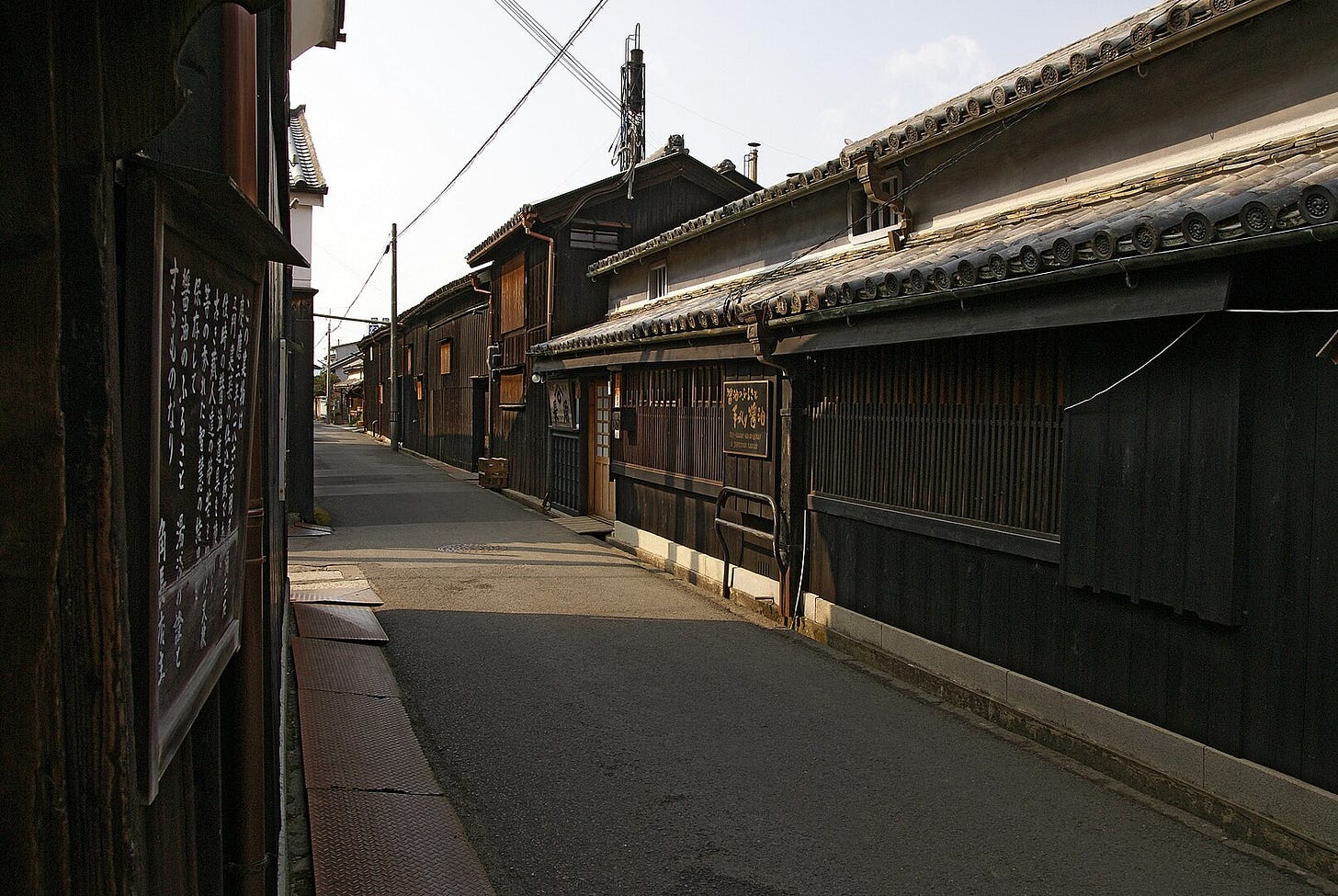
I bought a couple of bottles of soy sauce from one of the breweries and hoped to separate with my unwanted partner immediately thereafter. It wasn’t to be. He tried to insist that I wanted to go to the soy sauce museum. I looked inside; it looked like the kind of small local museum that bores the pants off school kids on a wet summer holiday in England — I declined. I wanted to go home, and the thought of a tour of the museum with commentary along the lines of “This, soy sauce. This, soy sauce making machine,” was pushing me toward the boundaries of rudeness.
I needed to go to the station I said. He showed me the way, pointing out temples and places I wasn’t much interested in while chatting loudly about how he had found an ALT (Assistant Language Teacher) and was showing him around Yuasa with a colleague on his phone.
One place he showed me was very interesting though, a traditional Japanese/Chinese medicine shop. In the window were pestles, mortars, and on one dusty shelf, a rhinoceros horn. I wondered about the legality of the horn. It looked old, presumably removed from the incapacitated rhinoceros before a ban on the poaching and sale of rhinoceros horns was implemented. But who knew? Was it still legal to display the horn? Did they occasionally grind bits off it to make medicine?
I finally waved Naoya off near the station. I felt ungrateful. He was clearly hurrying back to the soy sauce museum. He had taken his time to show me around, I never would have seen the traditional medicine shop without him. His comb-over flipped in the wind and he pasted it back as he rounded a corner and disappeared out of sight.





Julian, I don't really like to read long texts on a PC, but your stories are so good that I make an exception.
I guess we have to thank you, English people, for using your language as a lingua franca. So, you shouldn't complain.
As for "little to see at the site of the oji," look at those gorgeous trees!